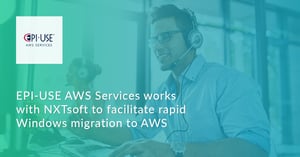If you watched Andy Jassy’s AWS re:Invent keynote presentation on December 1st or have watched an overview like what our friends at A Cloud Guru posted, you likely found many of the new features and services exciting. Well, we did too! Here are our Top 10 favorite announcements from the presentation, along with why we’re so excited.
1. Gp3 EBS Volumes
Three of our favorite announcements surrounded EC2 instances. The first is the newly announced gp3 EBS volumes, which can be easily migrated from the gp2 volumes they will replace, will allow users to customize their IOPS and Throughput on the volume. Gp3 increases IOPS up to 16,000 per volume, and Throughput peaks up to 1,000 MB/s, all at a lower price. The gp3 expands the definition of “general purpose” by bringing user-provisioning to the instance class without provisioning more storage capacity.
2. Babelfish for Aurora PostgreSQL
As helpful as a towel on your space travels, Babelfish for Aurora PostgreSQL allows you to transition your current Microsoft SQL Server database to Aurora PostgreSQL with minimal code changes. Babelfish, as its name suggests, is like a translator that speaks both T-SQL & PG-SQL, easing the headache of database migration by reducing the rewriting queries and learning new languages. Any service that allows for better, more seamless migrations for a client is an incredible asset, and Babelfish is an excellent example.
3. Amazon EC2 Mac instances for macOS
Next on the EC2 instances list that stood out to us is the EC2 Mac instance. This is the first and only on-demand macOS cloud instance, a macOS environment in the cloud for developers. Built on Mac minis, EC2 Mac instances allow for development consolidation of Apple, Windows, and Android apps with many of the commonly used AWS services such as VPC, EBS, and ELB. With AWS’s standard pay-as-you-go pricing, these new Mac instances allow for more straightforward, tighter, and cheaper development for your macOS teams.
4. Amazon Aurora Serverless v2
Aurora’s new on-demand auto-scaling configuration, Aurora Serverless v2, reduces costs by up to 90%. With no more size-doubling, the fine-tuned, incremental scaling that begins automatically, both up and down, is based entirely on the needs of your application. Aurora Serverless v2 can instantly scale to hundreds of thousands of transactions at small increments to match your app’s usage. This allows you to be charged only for what you use and removes the need to manage database capacity while still supporting the full capabilities of standard Amazon Aurora. For more on autoscaling, check out our blog from September 2019.
5. Amazon ECS Anywhere and EKS Anywhere
For those running in hybrid environments, ECS Anywhere and EKS Anywhere brings services directly to your native environments. These services are identical to their original counterparts in how they function while still being more versatile. They both provide your team with native AWS versions of themselves to be deployed on your systems, letting you launch containers and clusters on-premises and still use the typical service control panels—everything you love about ECS and EKS, now in your environment, with more centralized management.
6. Amazon EKS Distro
On top of that, EKS Distro removes the headache of needing to manage Kubernetes patching, whether security or general updates. EKS-D will also be Open Source, accessible via the project GitHub, giving even more flexibility to the developers on your team via access to older versions of Kubernetes after community support expires.
7. AWS Proton
We’ve always loved AWS for its ability to bring us centralized dashboards, and Proton is the newest service that will bring joy to your platform teams. Proton is the one-stop solution for managing tools, updates, monitoring, and infrastructure provisioning allowing teams to maintain up to thousands of microservices while speeding up your development. Proton also brings more straightforward ways to deploy code with serverless tech and containers while keeping best practices and consistent standards at the front of your processes.
8. Amazon QuickSight Q
These next two stand-out services, QuickSight Q and DevOps Guru bring machine learning power to your environments without the need for machine learning expertise. QuickSight Q allows your business teams to query your data without the need to learn a database language. Q understands everyday business language and can provide suggestions (via real-time text auto-complete), understands acronym/synonyms, and is always learning as users can correct answers. All of this provides you with a more straightforward way to view information about your data.
9. Amazon DevOps Guru
DevOps Guru is designed to identify the abnormal behavior of your applications and services by using years of operational data from Amazon.com. When a problem is identified, you receive a report that contains what DevOps Guru believes to be the root cause of the problem and the details around the occurrence. Ultimately, this allows you and your teams to be aware of problems and create a solution before affecting your end-user or other mission-critical services in your environment.
10. io2 Block Express
Number nine on our list is the third EC2 instance that stood out to us in this keynote. The io2 Block Express is designed to deliver up to 4x more storage, IOPS, and throughput than standard volumes at sub-millisecond latency and 99.999% durability, making it the preferred choice by customers for their performance-heavy applications. These new volumes bring SAN-like performance, reducing the need to stripe multiple volumes together, saving heavily on complexity and cost. On top of these benefits, your team will only be charged for the storage that you utilize.
Where we come in:
Afonza is your Atlanta-based AWS solutions company.
We are your AWS Partner team with many years of cloud infrastructure experience.


